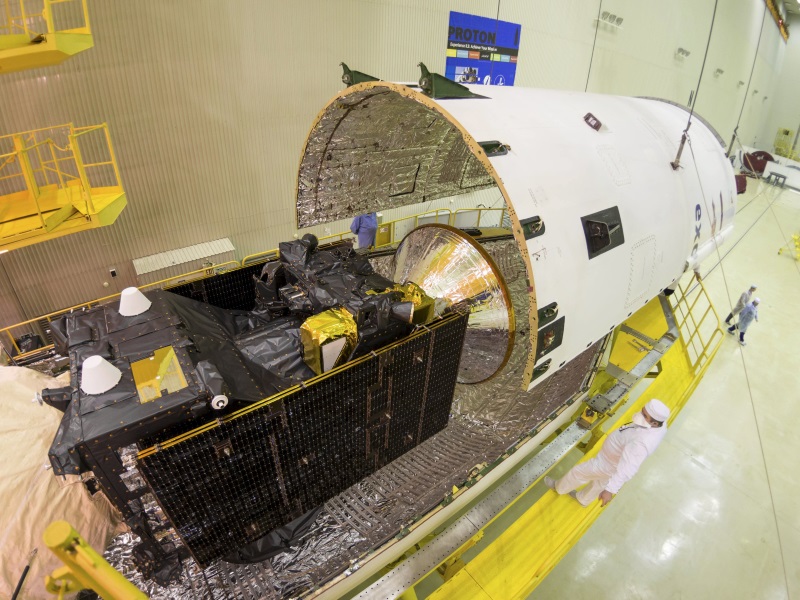- Home
- Science
- Science News
- Spacecraft to Seek Life on Mars in European Led Mission
Spacecraft to Seek Life on Mars in European-Led Mission

The craft, part of the European-Russian ExoMars programme, is to lift off from the Baikonur spaceport in Kazakhstan on board a Proton rocket at 5:31 A.M. EDT (0931 GMT) on Monday, starting a seven-month journey through space.
It will carry an atmospheric probe that will study trace gases, such as methane, around Mars as well as a lander that will test technologies needed for a rover due to follow in 2018.
US space agency Nasa's Mars rover Curiosity in late 2014 found spurts of methane gas in the planet's atmosphere, a chemical that on Earth is strongly tied to life.
Scientists believe the methane could stem from micro-organisms, called methanogenes, that either became extinct millions of years ago and left gas frozen below the planet's surface, or that some methane-producing organisms still survive.
"Proving that life exists or has existed on Mars would show that Earth is not unique in terms of having life on it," Rolf de Groot, head of the European Space Agency's (ESA) Robotic Exploration Coordination Office, told Reuters.
"That would make it much more likely that there are other places in the universe that also have life," he added.
Another explanation for the methane in Mars's atmosphere could be that it is produced by geological phenomena, like the oxidation of iron.
The second part of the ExoMars mission in 2018 will deliver a European rover to the surface of Mars. It will be the first with the ability to both move across the planet's surface and drill into the ground to collect and analyse samples.
"The radiation from space destroys all the biological material. If you go two metres into the ground you may be able to find places that were protected (from radiation)," de Groot said.
Landing on Mars is a notoriously difficult task that has bedevilled nearly all of Russia's previous efforts and has given Nasa trouble as well. The United States currently has two operational rovers on Mars, Curiosity and Opportunity.
The ExoMars 2016 mission is led by ESA, with Russia's Roscosmos supplying the launcher and two of the four scientific instruments on the trace gas orbiter. The prime contractor is Thales Alenia Space, a joint venture between Thales and Finmeccanica.
The cost of the ExoMars mission to ESA, including the second part due in 2018, is expected to be about EUR 1.3 billion (roughly Rs. 9,397 crores). Russia's contribution comes on top of that.
In 2018, Nasa also plans to launch a Mars spacecraft, a satellite known as InSight and designed to study the deep interior of Mars, the U.S. agency said this week.
© Thomson Reuters 2016
Catch the latest from the Consumer Electronics Show on Gadgets 360, at our CES 2026 hub.
Related Stories
- Samsung Galaxy Unpacked 2025
- ChatGPT
- Redmi Note 14 Pro+
- iPhone 16
- Apple Vision Pro
- Oneplus 12
- OnePlus Nord CE 3 Lite 5G
- iPhone 13
- Xiaomi 14 Pro
- Oppo Find N3
- Tecno Spark Go (2023)
- Realme V30
- Best Phones Under 25000
- Samsung Galaxy S24 Series
- Cryptocurrency
- iQoo 12
- Samsung Galaxy S24 Ultra
- Giottus
- Samsung Galaxy Z Flip 5
- Apple 'Scary Fast'
- Housefull 5
- GoPro Hero 12 Black Review
- Invincible Season 2
- JioGlass
- HD Ready TV
- Laptop Under 50000
- Smartwatch Under 10000
- Latest Mobile Phones
- Compare Phones
- OPPO Reno 15 Pro Max
- Honor Win RT
- Honor Win
- Xiaomi 17 Ultra Leica Edition
- Xiaomi 17 Ultra
- Huawei Nova 15
- Huawei Nova 15 Pro
- Huawei Nova 15 Ultra
- Asus ProArt P16
- MacBook Pro 14-inch (M5, 2025)
- OPPO Pad Air 5
- Huawei MatePad 11.5 (2026)
- Xiaomi Watch 5
- Huawei Watch 10th Anniversary Edition
- Acerpure Nitro Z Series 100-inch QLED TV
- Samsung 43 Inch LED Ultra HD (4K) Smart TV (UA43UE81AFULXL)
- Asus ROG Ally
- Nintendo Switch Lite
- Haier 1.6 Ton 5 Star Inverter Split AC (HSU19G-MZAID5BN-INV)
- Haier 1.6 Ton 5 Star Inverter Split AC (HSU19G-MZAIM5BN-INV)

















